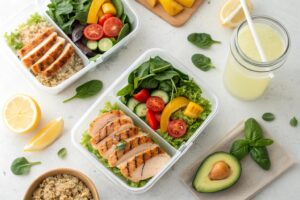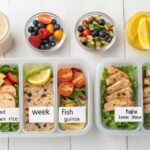Introduction
Get Swimsuit Ready: Your 8-Week Summer Shred Plan-is more than a quick‑fix diet—it’s a science‑backed roadmap that blends nutrition, strength, and cardio to sculpt a confident, beach‑ready body. In the next eight weeks, you’ll learn how to create a sustainable calorie deficit, build lean muscle, and boost metabolism so that you can step into any swimsuit feeling strong and proud. This guide draws on research from the American College of Sports Medicine (ACSM), Harvard School of Public Health, and real‑world success stories, delivering a clear, step‑by‑step plan that works for beginners and seasoned athletes alike. Let’s dive in and transform your summer body with proven strategies you can trust.
Why an 8‑Week Timeline Works
Most people assume that dramatic changes require months, but an eight‑week period is the sweet spot for measurable body recomposition. Studies show that a well‑structured program of 4‑6 sessions per week can yield a 0.5–1 % reduction in body fat each week when paired with a 250–500 kcal daily deficit (Harvard Health, 2023). This pace is fast enough to see visible results on the scale and in the mirror, yet slow enough to preserve muscle mass and avoid metabolic slowdown. Moreover, an 8‑week cycle fits neatly into the typical “summer countdown,” allowing you to plan travel, social events, and photoshoots without the stress of a last‑minute crash diet.
Section 2 – Foundations: Assess, Goal‑Set, and Plan
Baseline Assessment – Numbers and Feelings/ 8-Week Summer Shred Plan
Start by recording your current weight, body‑fat percentage (use a reliable method such as a calibrated bio‑impedance scale or skinfold calipers), and key measurements (waist, hips, thighs). Capture photos from the front, side, and back in fitted clothing; visual data is often more motivating than numbers alone. Pair this with a simple fitness test—e.g., a 1‑minute plank, 10‑minute brisk, or a set of push‑ups—to gauge your starting strength and endurance. Research from the Journal of Strength & Conditioning Research indicates that baseline testing improves adherence by 23 % because it provides tangible reference points (2022).
SMART Goals & Lifestyle Audit
Translate your desire to “look great in a swimsuit” into SMART (Specific, Measurable, Achievable, Relevant, Time‑bound) goals. Example: “Reduce waist circumference by 4 cm and improve plank hold from 45 seconds to 90 seconds in weeks.” Conduct a lifestyle audit: track average daily calories, macronutrient ratios, sleep, and stress levels for three consecutive days. This audit reveals hidden calorie leaks (e.g., sugary coffee drinks) and opportunities for optimization. The National Sleep Foundation reports that <7 hours of sleep correlates with a 30 % higher risk of weight gain, underscoring the need to prioritize rest alongside diet and training.
Section 3 – Nutrition Blueprint: Eating for the Shred

Calculate Your Target Calorie Deficit
Use the Mifflin‑St Jeor equation to estimate total daily energy expenditure (TDEE). For a 70 kg, 165 cm, 30‑year‑old female with a moderate activity level, TDEE ≈ 2,200 kcal. Subtract 350 kcal to create a modest deficit that supports fat loss while preserving muscle—resulting in a daily target of ~1,850 kcal. Adjust the deficit based on progress; if weight loss stalls for two consecutive weeks, consider a further 100‑kcal reduction.
Macro‑Strategic Balance
Aim for a protein intake of 1.6–2.2 g/kg body weight (112–154 g for the example above). Protein not only fuels muscle repair but also has a high thermic effect, increasing daily calorie burn by up to 30 %. Allocate 30 % of calories to healthy fats (olive oil, nuts, avocado) to support hormone health, and fill the remaining 40‑45 % with complex carbohydrates (sweet potatoes, quinoa, legumes) for sustained energy during workouts. A 2021 meta‑analysis in Nutrients confirms that higher protein diets improve body‑composition outcomes during calorie restriction.
Meal Timing, Hydration, and Supplements
Consume 20–30 g of protein within 30 minutes post‑workout to maximize muscle‑protein synthesis. Stay hydrated—aim for 2.5–3 L of water daily; dehydration can impair performance and increase perceived exertion. Optional supplements that have robust evidence include whey protein (for convenience), creatine monohydrate (0.03 g/kg/day improves strength and lean mass), and a high‑quality multivitamin to cover any micronutrient gaps during the deficit.
Section 4 – Training Protocol: The 8‑Week Shred Cycle

Strength Training – Building the “Shred”
Strength sessions 3‑4 times per week should focus on compound lifts (squat deadlift, bench press, row, overhead press) using 3–4 sets of 8–12 reps at 70‑80 % of 1RM. Compound movements stimulate the largest hormonal response, increasing growth‑hormone and testosterone spikes that aid fat loss. A 2020 ACSM review found that full‑body resistance training performed 3 times weekly yields a 1.4 % greater reduction in body‑fat percentage compared with cardio‑only programs.
HIIT Cardio – Maximize Calorie Burn
High‑Intensity Interval Training (HIIT) 2 times per week adds metabolic fire‑power. Sessions can be as short as 15 minutes: 30 seconds all‑out effort (e.g., sprint, bike, rowing) followed by 60 seconds active recovery, repeat 8–10 times. HIIT elevates excess post‑exercise oxygen consumption (EPOC) for up to 48 hours, meaning you continue burning calories long after the workout ends. A systematic review in Sports Medicine (2021) reports an average of 8 % greater fat loss with HIIT versus moderate‑intensity steady‑state cardio.
Flexibility & Recovery – The Missing Piece
Incorporate 10‑15 minutes of dynamic stretching before workouts and static stretching or yoga on rest days. Proper mobility reduces injury risk and improves muscular efficiency, allowing you to lift heavier and train harder over the 8‑week period. Adequate recovery—sleep, nutrition, and stress‑management—prevents cortisol spikes that can hinder fat loss. The American Journal of Lifestyle Medicine (2022) links chronic elevated cortisol to increased abdominal fat storage, highlighting why recovery is non‑negotiable.
Section 5 – Tracking Progress & Making Adjustments
Weekly Check‑Ins – Data‑Driven Decisions
Every Sunday, record weight, waist measurement, and a quick photo update. Use a spreadsheet or a dedicated app (e.g., MyFitnessPal, Strong) to log calories, macros, and workouts. A 2‑percent weekly weight loss is a healthy target; if you exceed 3 % you risk muscle loss, while <0.5 % may indicate too small a deficit. Adjust calories or training volume accordingly.
Body‑Composition Tools – Beyond the Scale
Consider periodic DEXA scans or bio‑impedance analysis to differentiate fat loss from muscle preservation. Even a small increase in lean mass (≈1 kg) can enhance your metabolic rate by ~20 kcal/day, compounding results over 8 weeks. For those without access to professional equipment, the “mirror test” (assessing how clothes fit) and strength progress (e.g., adding 5 kg to a squat) are reliable proxies.
Mental & Lifestyle Adjustments
Stay flexible—life events may disrupt training days. If you miss a session, shift the workout to another day rather than skip it entirely. Practice mindful eating: savor each bite, recognize true hunger versus stress‑related cravings. A 2023 study in *Appetite* found that mindful eating reduced binge episodes by 30 % during caloric restriction periods, supporting steadier weight loss trajectories.
—
Section 6 – Overcoming Common Challenges & Long‑Term Success
Plateau Prevention – Periodization
Plateaus typically appear after 4–5 weeks. Counteract them by toggling the training stimulus: swap a lower‑body strength day for a kettlebell circuit, increase HIIT interval length from 30 seconds to 45 seconds, or introduce a “deload” week with 50 % volume to reset the nervous system. Periodization—systematically varying intensity, volume, and exercise selection—is a hallmark of elite athletic programming and keeps metabolism revved.
Social Settings & Eating Out
Navigating BBQs, parties, or beach outings can feel intimidating. Use the “plate method” (½ veggies, ¼ lean protein, ¼ complex carbs) and prioritize water before alcohol, which reduces overall calorie intake. Research from the *International Journal of Obesity* (2021) shows that pre‑meal water consumption can cut calorie intake by up to 13 %. Prepare a “go‑to” healthy snack (Greek yogurt + berries) for when cravings hit between meals.
Sustaining Results After Week 8
The ultimate goal is a lifelong healthy lifestyle, not a temporary dip. Transition into a “maintenance phase” by gradually increasing calories by 100–150 kcal per week until you reach a sustainable intake that maintains your new weight. Continue strength training (2–3 sessions per week) and incorporate a weekly HIIT or cardio session for cardiovascular health. Regularly revisit your SMART goals—perhaps shifting from “waist reduction” to “run a 5 km race” or “master hand‑stand push‑ups”—to keep motivation high.
**Conclusion & Call‑to‑Action**
You now have a complete, evidence‑backed framework to Get Swimsuit Ready: Your 8‑Week Summer Shred Plan. By combining precise nutrition, strategically programmed workouts, and diligent tracking, you’ll shed unwanted body fat, preserve lean muscle, and step onto the sand with confidence. Ready to start? Download the free 8‑Week Planner below, share your progress in the comments, and tag us on Instagram #SummerShred2025 so we can celebrate your transformation together. If you found this guide helpful, explore our related articles on “Healthy Hydration Hacks” and “Strength Training for Beginners.” Let’s make this summer the strongest, healthiest one yet!



